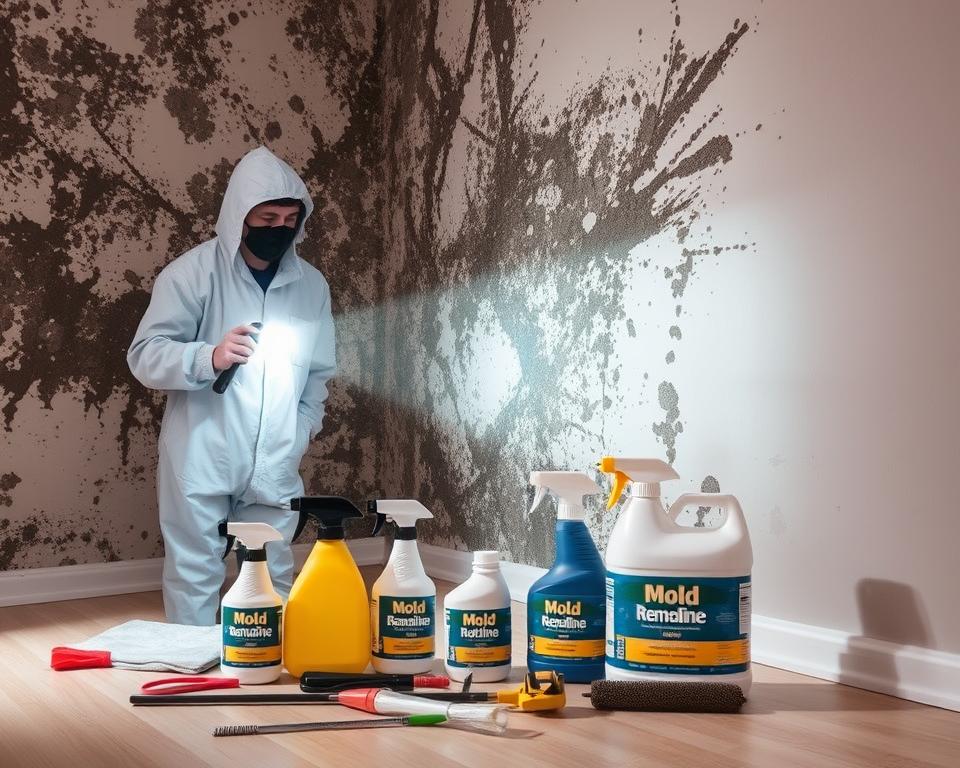Hidden threats often lurk in damp corners and poorly ventilated spaces. When dark spots appear on walls or ceilings, they signal more than just cosmetic flaws. These unwelcome growths thrive where moisture lingers, creating potential health hazards and structural damage over time.
Addressing these issues quickly matters for both safety and budget. Professional cleanup services analyze affected areas to create tailored solutions. Factors like labor expenses, material requirements, and space measurements determine final costs. Some companies offer reduced pricing structures based on project scope, making thorough cleanup more accessible.
While DIY methods exist for minor cases, experts like John Parks emphasize that “improper handling often worsens contamination.” Understanding what influences pricing helps homeowners make informed decisions. Later sections will reveal cost ranges from industry leaders and actionable tips for balancing quality with affordability.
Key Takeaways
- Early intervention prevents costly structural repairs
- Professional assessments identify hidden moisture sources
- Pricing depends on contamination severity and space dimensions
- Specialized equipment ensures complete spore elimination
- Seasonal promotions may lower service expenses
Understanding Mold Remediation Costs
Eliminating biological contaminants from homes involves multiple financial considerations. Recent data from Angi and Forbes shows homeowners spend $2,361 on average, with projects ranging from $373 to $7,000. Smaller areas under 10 square feet often cost less than $500, while extensive infestations exceeding 100 square feet can exceed $6,000.
Pricing Variables by Project Size
| Affected Area | Average Cost | Price Range |
|---|---|---|
| Small (under 10 sq.ft) | $500 | $373 – $650 |
| Medium (10-50 sq.ft) | $2,100 | $1,500 – $3,000 |
| Large (50-100 sq.ft) | $4,800 | $3,000 – $6,000 |
| Severe (100+ sq.ft) | $7,000+ | $6,200 – $12,000 |
Breaking Down Service Charges
Labor accounts for 60-70% of total expenses according to industry reports. Certified technicians use specialized equipment like air scrubbers and antimicrobial treatments. Material costs include protective gear and replacement building supplies when structural damage occurs.
“Pricing reflects both visible damage and hidden moisture sources,” notes Angi’s home improvement analysis team. “Multi-room projects require advanced containment measures, increasing labor hours.”
Surface type also impacts budgets. Porous materials like drywall often need full replacement, while non-porous surfaces may only require deep cleaning. Always request itemized estimates to compare service inclusions.
How Mold Remediation Works
Professional biological decontamination follows a precise sequence to ensure safety and effectiveness. Certified teams begin by evaluating contamination levels before creating action plans tailored to each situation.
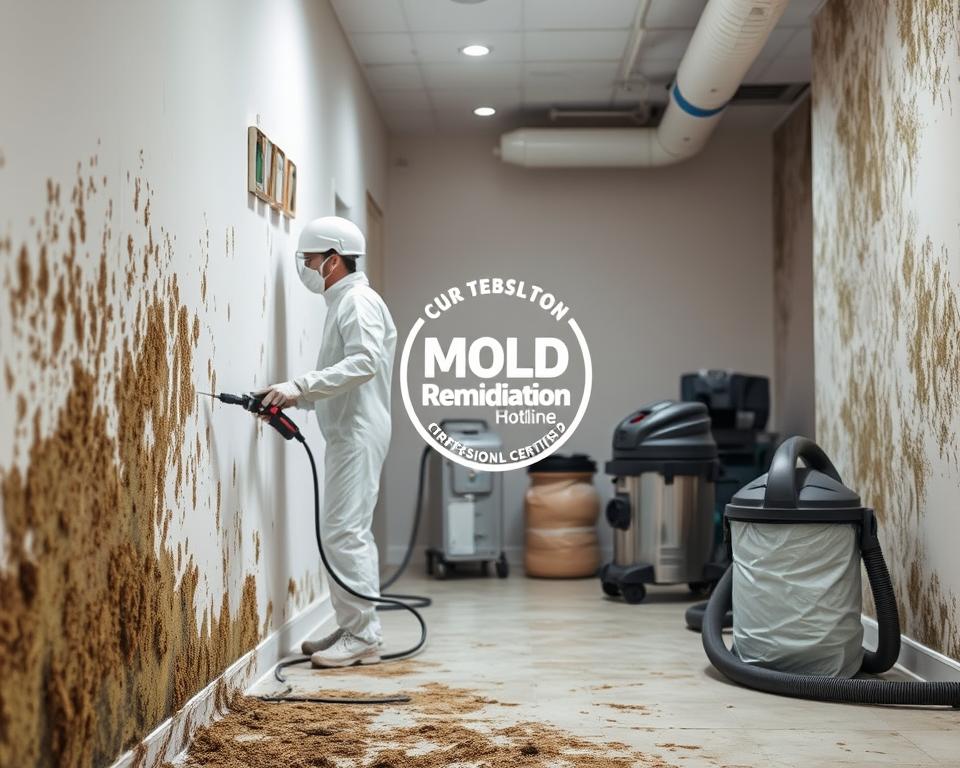
Inspection and Assessment Procedures
Technicians start with thorough visual examinations and moisture mapping. Advanced tools like infrared cameras detect hidden water sources, while air quality tests identify spore concentrations. These findings determine containment needs and influence remediation costs.
| Phase | Tools/Methods | Purpose |
|---|---|---|
| Assessment | Moisture meters, lab testing | Identify contamination scope |
| Containment | Plastic sheeting, negative air pressure | Prevent spore spread |
| Removal | HEPA vacuums, specialized brushes | Eliminate growth |
| Cleanup | Antimicrobial sprays, air scrubbers | Restore air quality |
Containment and Cleanup Steps
Work zones get sealed with physical barriers to isolate affected areas. Professionals wear protective gear while removing compromised materials. Air filtration systems run continuously to capture airborne particles during the process.
Final sanitation involves applying EPA-approved solutions to surfaces. John Parks emphasizes that “cutting corners during cleanup often leads to recurring issues.” This meticulous approach explains why most projects require trained specialists rather than amateur attempts.
Leveraging Mold Removal Discounts Per Square Foot
Smart financial planning plays a crucial role in managing biological growth issues. Many service providers offer tiered pricing models tied to space dimensions, creating opportunities for savings. Larger projects often qualify for scaled rates that reduce per-unit expenses while maintaining quality standards.
Consider this scenario: A homeowner discovers growth across 80 square feet of their basement. Professional measurement reveals the full scope, allowing them to access bulk service discounts. This approach lowered their final bill by 18% compared to standard hourly rates.
| Area Size | Standard Rate | Discounted Rate | Savings |
|---|---|---|---|
| Under 50 sq.ft | $3.50 | $3.15 | 10% |
| 50-100 sq.ft | $3.25 | $2.75 | 15% |
| 100+ sq.ft | $3.00 | $2.40 | 20% |
Accurate evaluations matter. Certified specialists use laser measurements and moisture mapping to identify eligible zones. “Misjudging dimensions leads to incomplete treatments,” warns EPA-certified inspector Mara Lin. Precise calculations prevent repeat visits and unexpected charges.
Homeowners in Texas recently saved $1,200 by combining seasonal promotions with area-based pricing. Always ask providers about:
- Volume discounts for multi-room projects
- Package deals including air quality testing
- First-response incentives for urgent cases
Request written estimates that break down spatial measurements and applicable reductions. This transparency helps compare offers while ensuring thorough service coverage.
Factors That Influence Mold Remediation Costs
The complexity of eliminating unwanted biological growth depends on several critical variables. Property owners must consider contamination depth, material vulnerabilities, and potential health risks when budgeting for professional services. These elements interact to create unique pricing scenarios for each situation.
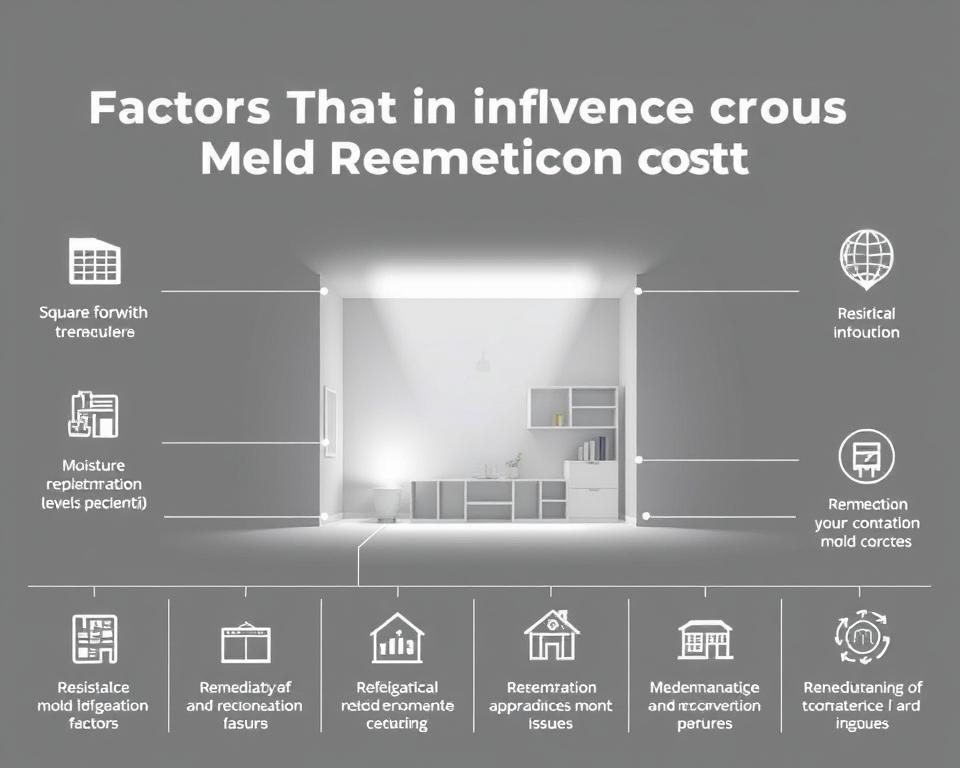
Severity of Infestation and Affected Area
Larger contaminated zones require more resources to address. Spaces exceeding 50 square feet often need advanced containment systems and extended labor hours. Deep-rooted growth behind walls or under flooring compounds expenses due to structural access challenges.
Water intrusion dramatically escalates costs. Robert Weitz, a certified environmental specialist, notes: “Chronic leaks create ideal breeding grounds, forcing technicians to address both visible growth and hidden moisture reservoirs.” This dual focus increases treatment time by 30-45% in many cases.
Material and Health Considerations
Porous building components like drywall or insulation frequently require complete replacement. Non-porous surfaces such as tile may only need deep cleaning. Material disposal fees and reconstruction needs add $8-$15 per square foot in many projects.
Toxic variants demand specialized protocols. Protective gear upgrades and airlock installations become necessary when dealing with hazardous strains. These precautions protect workers and occupants but raise service fees by 18-25% compared to standard treatments.
Balancing thorough cleanup with financial practicality requires understanding these variables. Always request detailed assessments that account for both physical damage and airborne risks before approving services.
Calculating Costs: Area, Materials, and Labor
Budgeting for home decontamination requires careful evaluation of three core elements. Space dimensions, surface characteristics, and workforce requirements each impact final expenses. Accurate measurements help homeowners compare service options effectively.
Estimating Square Foot Pricing
Professionals typically calculate charges using contaminated space measurements. Standard rates range from $3.50 to $7.00 per unit area depending on these factors:
- Surface accessibility (open walls vs cramped crawlspaces)
- Material porosity (fabrics vs concrete)
- Local labor rates ($45-$85 hourly)
| Space Type | Cleaning Cost | Replacement Cost | Savings Potential |
|---|---|---|---|
| Bedroom Drywall | $4.50 | $6.80 | 34% |
| Basement Concrete | $3.75 | N/A | Full cleaning |
| Attic Insulation | $5.20 | $4.90 | 6% |
Replacement Versus Cleaning Decisions
Non-porous surfaces like tile often undergo deep cleaning. Porous materials like carpet may need full removal. Certified inspector Lisa Monroe advises: “Structural replacements become necessary when contamination penetrates beyond surface level.”
Labor costs combine with material expenses to determine total investments. For example, attic insulation work might cost $1,200 for replacement versus $1,400 for intensive cleaning. Always request breakdowns showing:
- Material disposal fees
- Protective equipment costs
- Post-cleanup verification tests
Understanding the type of biological growth and affected materials helps prioritize actions. Regular monitoring prevents minor issues from escalating into major work projects.
DIY Versus Professional Mold Remediation
Homeowners facing biological growth issues often grapple with the decision between self-treatment and expert intervention. While store-bought cleaners promise quick fixes, complex cases demand specialized solutions. Let’s examine when personal efforts suffice and when calling specialists becomes unavoidable.
Risks and Limitations of DIY Approaches
Over-the-counter sprays might temporarily mask visible growth but rarely address root causes. A 2022 EPA study found 68% of DIY attempts failed to eliminate hidden spores, leading to recurring problems within six months. Common pitfalls include:
- Inadequate protective gear exposing residents to respiratory irritants
- Improper containment spreading contaminants to unaffected areas
- Surface-level cleaning missing embedded growth in wall cavities
Certified inspector Carla Ruiz recalls a case where homeowners used bleach on attic growth: “They unknowingly dispersed spores through their HVAC system, tripling cleanup costs.” Such scenarios highlight why professional mold services often prove cheaper long-term.
Critical warning signs demand expert attention. Seek specialists if you notice:
- Musty odors persisting after cleaning
- Water damage history in affected spaces
- Health symptoms worsening near contaminated areas
Companies like ServPro and PuroClean use infrared scanners to detect moisture sources, preventing future mold infestations. Their containment protocols ensure complete spore removal, addressing both visible problems and hidden risks. While upfront costs appear higher, this approach helps prevent mold regrowth and structural decay.
Regional Variations in Mold Remediation Pricing
Service charges for addressing fungal growth vary dramatically across different parts of the United States. Coastal metropolitan areas like San Francisco and New York City typically charge 40-60% more than rural Midwest communities. This disparity stems from differences in labor expenses, housing density, and local environmental regulations.
| Region | Average Cost Range | Key Influencers |
|---|---|---|
| California | $4.50 – $8.00 | Strict containment laws |
| Midwest | $2.75 – $5.50 | Lower wage rates |
| Southern States | $3.25 – $6.25 | High humidity levels |
Urban centers face higher operational costs due to stringent safety protocols. “Licensing requirements in cities like Boston add 15-20% to project estimates,” explains industry analyst Mark Tilden. Southern states combat frequent moisture issues, while Midwestern providers often handle basement-related cases.
Climate patterns directly impact service frequency and complexity. Gulf Coast technicians regularly address storm-related water damage, whereas arid Southwest regions see fewer cases. These environmental factors shape per square pricing structures over time.
Homeowners should request location-specific quotes when budgeting. Comparing cost mold remediation averages within your state ensures realistic expectations. Always verify if estimates include post-cleanup air quality tests, as these services vary by provider.
Prevention and Maintenance to Avoid Mold Infestations
Maintaining a healthy indoor environment starts with proactive measures against moisture buildup. Controlling humidity levels below 60% disrupts the conditions that allow biological growth to thrive. Simple daily habits and seasonal checks create barriers against unwanted invaders.
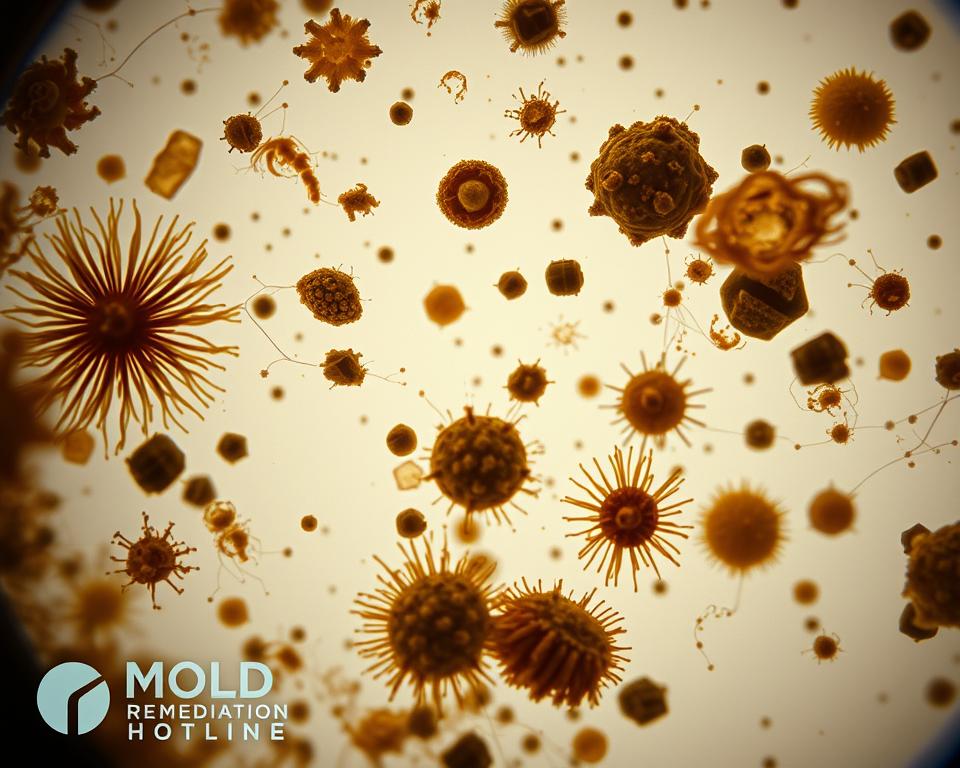
Moisture Control and Ventilation Tips
Fix dripping faucets and leaking pipes immediately. Even minor water accumulations behind walls can create breeding grounds. Use moisture meters in basements and crawl spaces to catch issues early.
High-humidity zones like bathrooms need exhaust fans running during showers. Leave them on for 20 minutes afterward to clear steam. In kitchens, open windows when cooking or use range hoods to vent excess heat and moisture.
- Install dehumidifiers in damp areas during humid months
- Inspect roof shingles annually after severe weather
- Clean gutters regularly to prevent water seepage
Schedule quarterly HVAC maintenance to ensure proper airflow. Replace filters every 90 days to trap airborne particles. Air quality tests every six months help identify spore concentrations before they escalate.
“Consistent ventilation is cheaper than remediation,” says home inspector Dana Torres. “Cross-breezes from open windows and ceiling fans reduce stagnant air where spores settle.”
Wipe down shower walls after use and dry wet surfaces within 24 hours. These routines, combined with smart humidity tracking, form the first defense against costly cleanup projects.
Expert Tips to Reduce Mold Remediation Costs
Effective strategies can dramatically lower expenses when dealing with household contaminants. Acting quickly after discovery prevents minor issues from escalating into major financial burdens. Industry specialists emphasize combining prevention with professional insights for optimal results.
Timely Intervention Benefits
Contamination spreads rapidly in humid environments. Certified inspector Tara Wells states: “Addressing growth within 48 hours reduces cleanup costs by 40% on average.” This urgency proves critical when dealing with toxic varieties like black mold, which requires specialized handling.
Regular monitoring of high-risk areas helps catch problems early. Focus on:
- Checking under sinks weekly
- Inspecting basement corners monthly
- Scheduling professional air tests annually
Budgeting for Unexpected Expenses
Set aside 15-20% above initial estimates for hidden complications. Common surprises include:
- Undetected moisture behind walls
- Airborne spore colonies requiring filtration
- Structural repairs from prolonged exposure
Environmental specialist Kyle Renner advises: “Create a contingency fund matching your home’s square footage. Larger properties need bigger buffers.” This preparation prevents financial strain during critical containment phases.
Combine these strategies with professional assessments to balance safety and affordability. Early action paired with smart budgeting protects both health and savings.
The Role of Materials and Structural Concerns in Mold Removal
Building materials directly influence contamination spread and treatment complexity. Porous surfaces like drywall absorb moisture, creating hidden reservoirs for biological growth. Professionals prioritize structural assessments to determine whether cleaning suffices or full replacement becomes necessary.
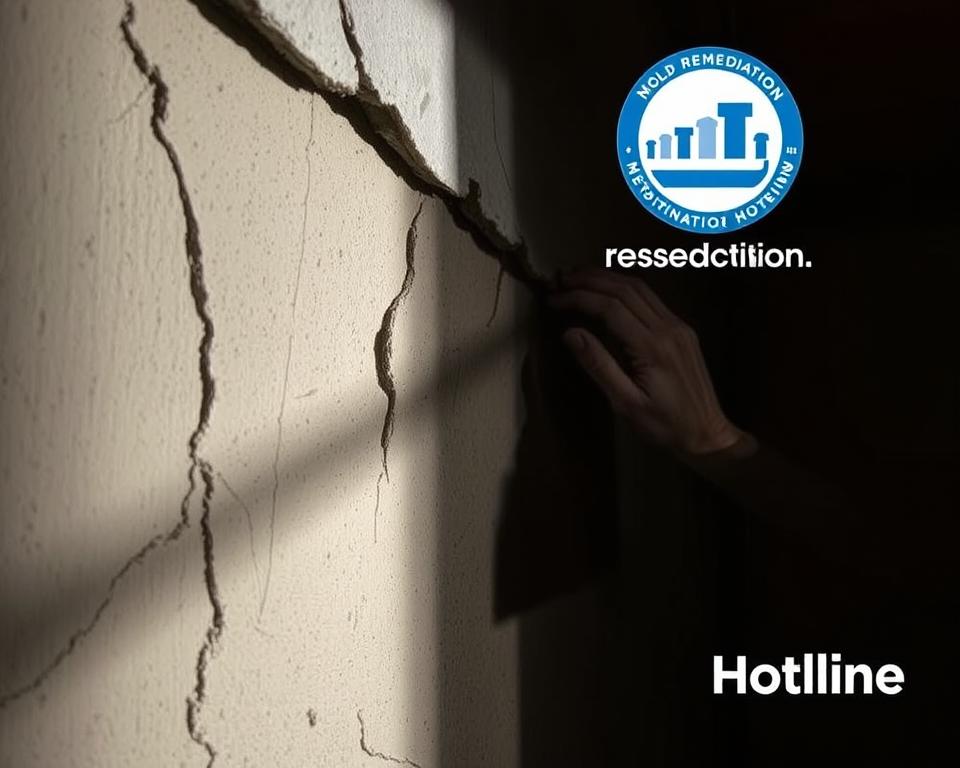
Material Evaluation Strategies
Certified inspectors examine walls, insulation, and subflooring using moisture meters and infrared scanners. These tools reveal compromised areas invisible during visual checks. Contaminated drywall often requires cutting out affected sections to prevent spore migration.
| Material Type | Inspection Method | Common Action |
|---|---|---|
| Drywall | Moisture probes | Partial/full replacement |
| Fiberglass Insulation | Thermal imaging | Complete removal |
| Wood Studs | Surface scraping | Antimicrobial treatment |
Restoration challenges increase when growth penetrates load-bearing walls. Contractor Lisa Monroe explains: “Structural integrity assessments guide whether we salvage materials or rebuild sections from studs outward.” Non-porous surfaces like vinyl siding may only need deep cleaning if addressed early.
Homeowners face critical decisions when biological growth infiltrates building materials. While cleaning costs less initially, deeply embedded contamination often demands replacement. Professional diagnostics identify compromised areas accurately, preventing recurring issues.
“Materials testing determines treatment scope better than visual estimates,” states building biologist Darren Cole. “We’ve prevented $14,000 in future repairs by replacing 12 square feet of subflooring during initial remediation.”
Always consult specialists before attempting DIY fixes on structural components. Their expertise balances safety protocols with cost-effective solutions tailored to your home’s unique needs.
Understanding the Containment and Cleanup Process
Professional decontamination relies on precise isolation and purification methods. Certified teams prioritize preventing spore migration during treatment. Their approach combines physical barriers with advanced filtration to protect unaffected areas.
Step 1: Containment Procedures
Work zones get sealed using thick plastic sheeting and negative air pressure systems. This setup ensures airborne particles stay within designated areas. Technicians wear full-body suits and respirators while establishing these safeguards.
| Containment Tool | Purpose | Usage Duration |
|---|---|---|
| Polyethylene Barriers | Block spore spread | Entire project |
| Negative Air Machines | Filter contaminated air | 6-12 hours daily |
| Decontamination Chambers | Protect workers | During entry/exit |
Step 2: Air Scrubbing and Surface Cleaning
HEPA-filtered vacuums remove particles from surfaces and air simultaneously. Antimicrobial solutions treat affected materials, while air scrubbers cycle the environment 4-6 times per hour. Specialized services often include post-cleanup air testing to verify results.
Contaminated debris gets double-bagged in sealed containers for safe disposal. “Improper waste handling undermines entire projects,” warns EPA-certified specialist Mara Lin. Proper protocols prevent recurring issues and protect community health.
Combining these steps ensures thorough elimination of harmful spores. Regular equipment calibration and staff training maintain service quality across all phases.
Comparative Analysis of Mold Removal Pricing Structures
Home restoration expenses vary widely based on service models and regional factors. Service providers typically offer three main approaches: area-based rates, flat fees for defined spaces, and customized packages. Each method carries distinct financial implications for property owners.
| Pricing Model | Average Cost | Best For | Limitations |
|---|---|---|---|
| Per Unit Area | $3.20 – $6.80 | Localized issues | Hidden damage upcharges |
| Room Packages | $1,200 – $4,500 | Multi-space projects | Standardized treatments |
| Custom Plans | $5,000+ | Structural damage | Extended timelines |
Toxic varieties like Stachybotrys increase cost mold remediation by 25-40% compared to common strains. A Florida case study showed attic treatments costing $4,800 under area pricing versus $3,900 via room packages. However, the latter excluded subfloor repairs.
Regional differences further complicate comparisons. HomeAdvisor data reveals:
- Midwest basements: $2.75-$4.10 per unit
- Pacific Northwest bathrooms: $5.60-$7.20 per unit
- Southwest HVAC systems: $1,800 flat rate
“Restoration add-ons account for 38% of final bills in water-damaged properties,” states a 2023 industry report. Air quality testing alone adds $300-$600 to projects.
Package deals often provide better range for predictable budgets but may overlook hidden issues. Custom plans address complex cases but require detailed assessments. Always verify if estimates include post-treatment verification scans.
Key Considerations for Homeowners
Evaluating household contamination requires systematic checks and awareness of warning signs. Property owners should prioritize identifying both visible growth and hidden risks to protect their living spaces. Three critical factors determine response strategies: contamination depth, material vulnerability, and air quality impacts.
Damage Assessment Checklist
Use this guide to gauge contamination severity and necessary actions:
| Area | Warning Signs | Recommended Response |
|---|---|---|
| Bathrooms | Discolored grout, peeling paint | Surface cleaning |
| Basements | Musty odors, warped materials | Professional inspection |
| HVAC Systems | Dust buildup, allergy symptoms | Duct sanitization |
Surface-level issues often appear as isolated spots. Deeper infestations cause structural warping or persistent odors. Dr. Elena Morris, an environmental health expert, warns: “Ignoring respiratory symptoms near contaminated zones risks long-term health complications.”
HVAC units demand special attention. Spores circulating through ventilation systems can affect entire homes. Schedule duct inspections if family members experience unexplained allergies or headaches.
When consulting specialists, ask:
- Which type of growth requires targeted treatments?
- Does your quote include post-cleanup air testing?
- How will you prevent cross-contamination during work?
Understanding mold remediation costs starts with accurate damage assessments. Certified professionals use moisture meters and infrared tools to map affected areas, ensuring quotes reflect true project scope.
Conclusion
Managing household contamination requires balancing urgency, expertise, and smart budgeting. This guide has outlined how contamination severity, material types, and spatial measurements shape remediation costs. Acting quickly often reduces expenses while preventing health risks linked to poor air quality.
Professional services provide critical advantages. Certified teams address both visible growth and hidden moisture sources, ensuring thorough results. Their use of specialized equipment and containment protocols protects your home’s structural integrity.
When reviewing quotes, prioritize companies that offer transparent area-based pricing and post-cleanup air testing. These practices help verify service quality while maximizing savings. Regular inspections and humidity control further minimize future risks.
By understanding cost factors and leveraging expert insights, homeowners can make informed decisions. A proactive approach safeguards your living environment and financial well-being for years to come.
